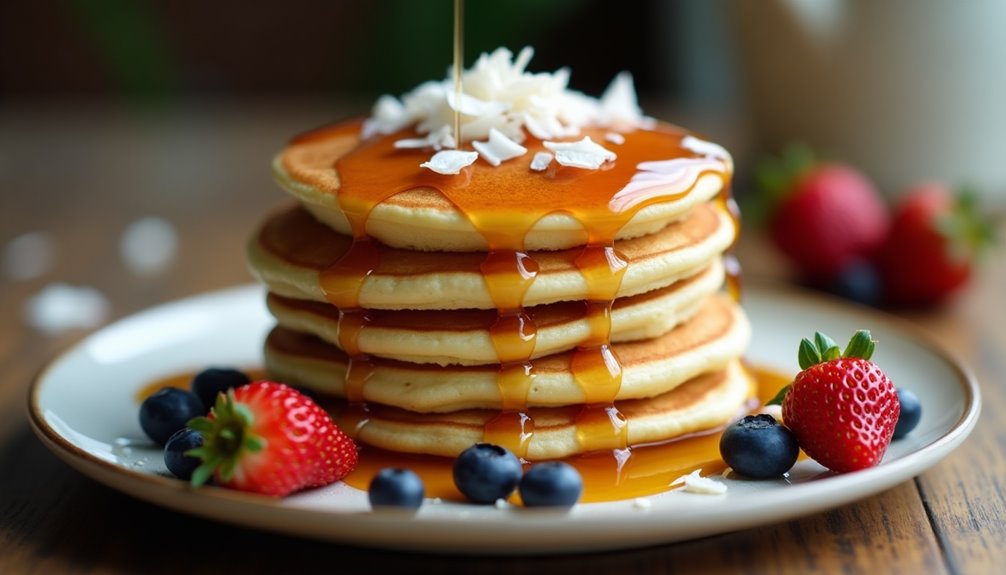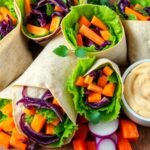Coconut flour pancakes make for a scrumptious, gluten-free breakfast that you'll adore. Packed with fiber and healthy fats, these pancakes keep you full and energized. Start with coconut flour, eggs, milk, and a sweetener to create a smooth batter. Cook them to fluffy perfection, and enjoy the delightful texture. You can even jazz them up with vanilla, blueberries, or a sprinkle of cinnamon. Top them with maple syrup or fresh berries for a delicious finish. They're easy to store and reheat, ensuring your breakfast can be enjoyed all week. You'll love discovering more tips and tricks to elevate your pancake game!
Key Takeaways
- Coconut flour pancakes are gluten-free, high in fiber, and provide sustained energy, making them a nutritious breakfast option.
- Essential ingredients include coconut flour, eggs, milk, sweeteners, and baking powder for a delicious batter.
- Customize your pancakes with flavors like vanilla, cinnamon, or cocoa, and add ingredients like blueberries or nut butters.
- Store pancakes in an airtight container or freeze for up to three months to maintain freshness and flavor.
- Reheat in the microwave or skillet for crispy edges and enjoy with toppings like maple syrup, yogurt, or fresh berries.
Benefits of Coconut Flour
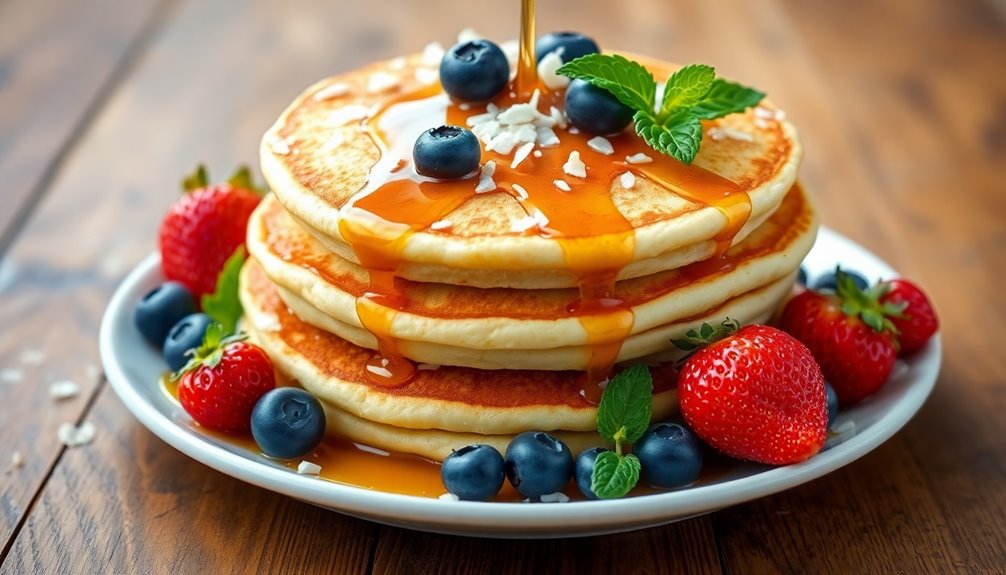
Coconut flour offers several impressive benefits that make it a fantastic choice for your pancake recipes.
First and foremost, its nutritional value shines through. Packed with fiber, healthy fats, and essential proteins, coconut flour not only fuels your body but also keeps you feeling fuller for longer. This means your pancakes can be a wholesome meal, providing sustained energy throughout your day.
If you're looking for a gluten-free option, coconut flour is a game-changer. It gives you the chance to enjoy delicious pancakes without the worry of gluten-related sensitivities. You can savor the fluffy texture and sweet flavor without compromising your dietary needs or preferences. Plus, it's incredibly versatile; you can blend it with other flours to create an even more delightful pancake experience.
Using coconut flour also supports a more sustainable lifestyle. Coconut trees are known for their resilience and ability to thrive in less-than-ideal conditions, making them an eco-friendly choice. By incorporating coconut flour into your kitchen, you're not just treating yourself; you're also making a mindful decision about your food sources.
Essential Ingredients
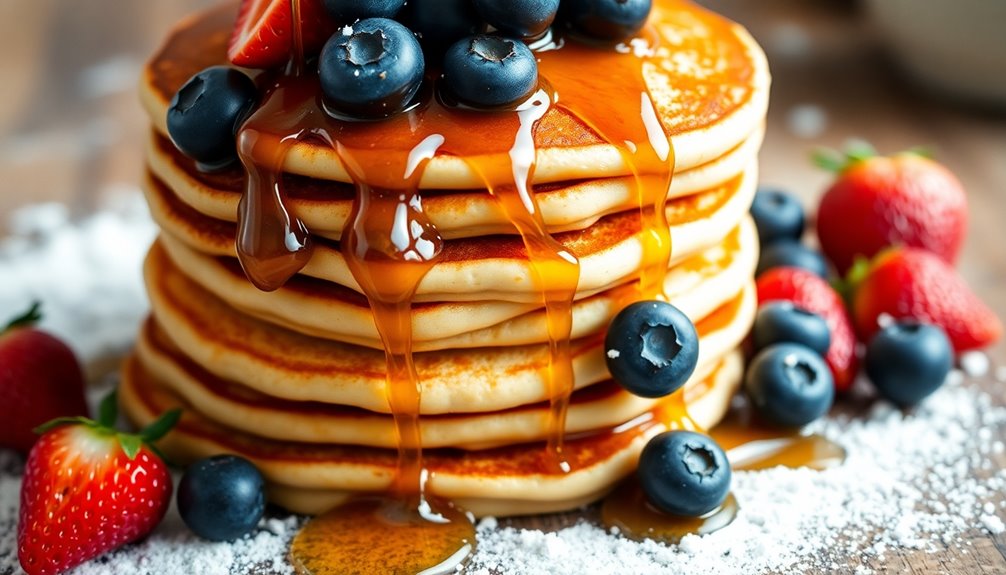
When you're all set to whip up some delectable pancakes, gathering the right ingredients is crucial to achieving that perfect fluffy texture and rich flavor. Coconut flour takes the spotlight, offering a distinct taste and impressive nutritional value. When selecting coconut flour, opt for top-notch brands that guarantee high quality and freshness, such as Bob's Red Mill or Anthony's. These brands are recognized for their dedication to obtaining premium ingredients, turning your pancakes into a wholesome delight.
Next, you'll require eggs to provide structure and moisture. Eggs not only bind the ingredients together but also contribute protein, boosting the nutritional value of your pancakes. If you follow a vegan diet or have allergies, consider using a flaxseed meal or chia seed substitute, which works just as well.
Don't overlook the milk! Whether you fancy almond, coconut, or traditional dairy, the milk adds creaminess and helps achieve the desired batter consistency. Sweetening your pancakes is also crucial, and natural options like honey or maple syrup can enhance the flavor without overwhelming it.
A hint of salt counteracts the sweetness and enhances the overall flavor. To finish, a tad of baking powder gives your pancakes a lift, ensuring they're airy and fluffy.
With these essential ingredients, you're on the right track to making delightful coconut flour pancakes that not only taste fantastic but also nourish your body. So gather your supplies and get ready to savor a scrumptious, fulfilling breakfast that you can enjoy with loved ones!
Step-by-Step Recipe
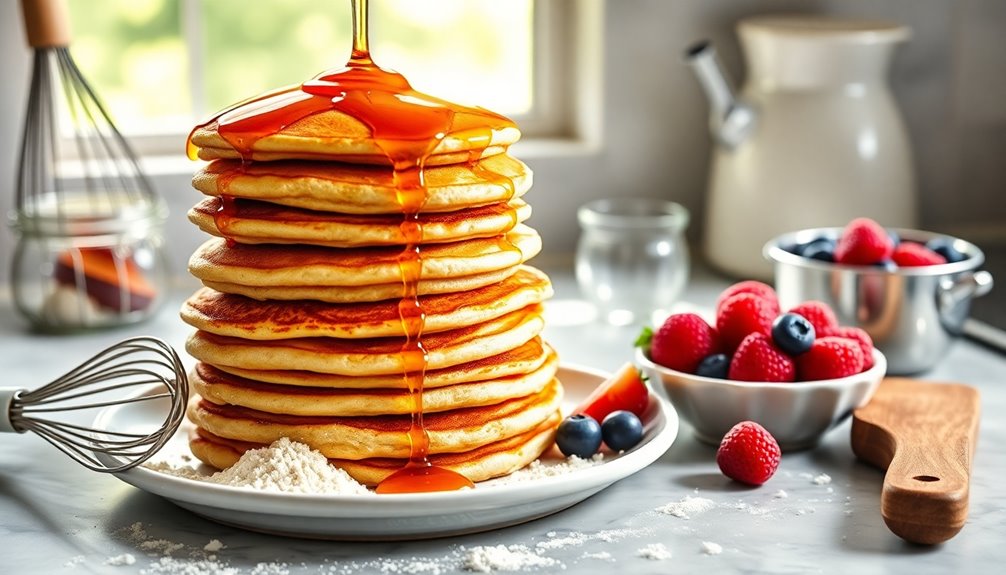
To create delicious coconut flour pancakes, you'll want to start by mixing your dry ingredients in a bowl. Combine 1/2 cup of coconut flour, 1 teaspoon of baking powder, and a pinch of salt. Coconut flour is packed with fiber and healthy fats, so not only are you making a tasty breakfast, but you're also reaping nutritional benefits.
Next, in another bowl, whisk together your wet ingredients: two eggs, 1/4 cup of milk (dairy or non-dairy works), and a tablespoon of honey or maple syrup for sweetness. Make sure to blend them well; this is key to a smooth cooking process.
Now, gently fold the wet mixture into the dry ingredients. You'll notice that the batter is thicker than typical pancake batter, which is perfectly normal due to the absorbent nature of coconut flour. Let the batter sit for about five minutes. This allows the coconut flour to soak up the liquids, enhancing the pancake's texture.
While the batter rests, heat a non-stick skillet over medium heat. Lightly grease it with coconut oil or butter. Once the skillet is hot, pour about 1/4 cup of batter for each pancake. Cook until you see bubbles forming on the surface, then flip and cook for another minute or two until golden brown.
Serve warm with your favorite toppings, like fresh fruit or a drizzle of syrup, and enjoy a breakfast that's not only scrumptious but also nourishing for your body.
Cooking Tips and Techniques
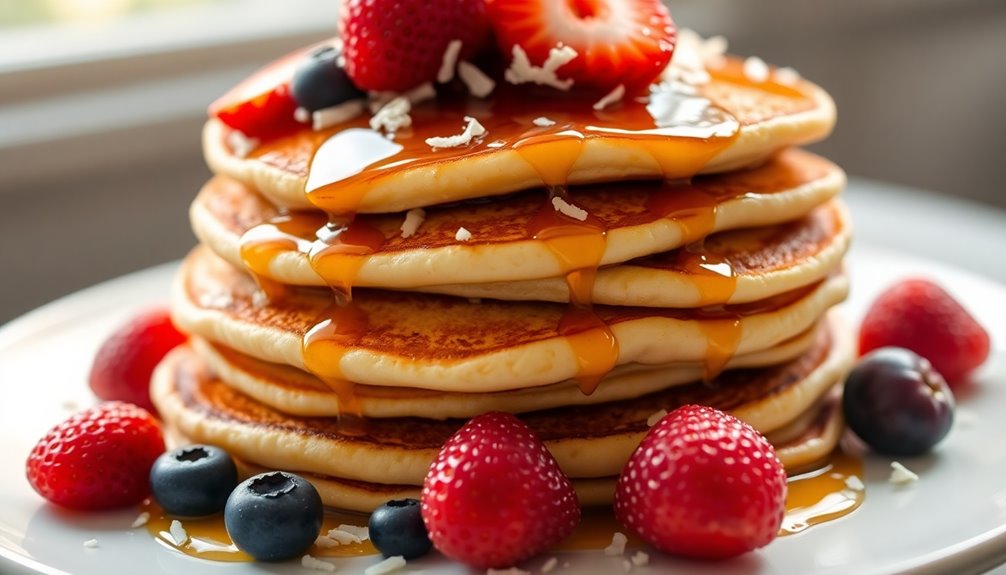
Mastering the art of preparing coconut flour pancakes involves a few key methods that enhance your breakfast experience. When working with coconut flour, the mixing method is essential. You'll want to blend your dry ingredients thoroughly before adding any liquids. This guarantees a uniform spread of flavors and prevents lumps in your batter. Once you incorporate the eggs and milk, mix until you achieve a smooth batter texture. Keep in mind, coconut flour absorbs more liquid than regular flour, so adjust the moisture as necessary.
Next, pay attention to your cooking temperature. A moderate heat is ideal; too high, and you risk scorching the pancakes before they are fully cooked. Use a non-stick skillet or griddle for optimal results. When it's time to flip your pancakes, follow a gentle flipping technique. Wait until you observe bubbles forming on the surface—this signals they're ready to be turned.
Here's a quick reference table to assist you:
| Method | Tips |
|---|---|
| Mixing Method | Blend dry ingredients first for uniform distribution |
| Batter Texture | Strive for a smooth, pourable batter; adjust liquid as necessary |
| Cooking Temperature | Opt for medium heat to prevent scorching |
| Flipping Technique | Flip when bubbles appear; handle gently to avoid breakage |
Flavor Variations
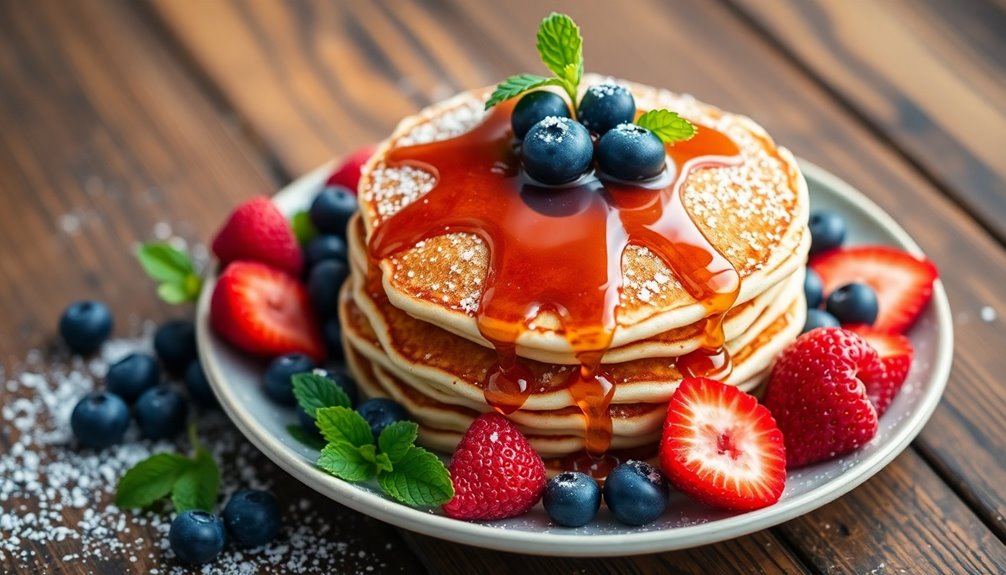
Coconut flour pancakes offer a delightful canvas for a variety of flavors that can elevate your breakfast to new heights. You can easily customize these pancakes to suit your taste buds with simple ingredient swaps and exciting flavor combinations. Why stick to plain when you can infuse your pancakes with vibrant flavors?
Consider adding a splash of vanilla extract or a sprinkle of cinnamon to your batter for a cozy, warm taste. If you're feeling adventurous, mix in some cocoa powder for a chocolatey twist or even a bit of pumpkin puree for a seasonal treat. These additions not only enhance the flavor but also provide a delightful texture.
For a tropical flair, try incorporating crushed pineapple or shredded coconut directly into the batter. You'll create a mini-vacation on your plate!
Don't forget about fruits; blueberries, bananas, or chopped apples can add a burst of freshness and natural sweetness.
If you want a protein boost, think about swapping out some of the liquid with almond milk or adding in a scoop of protein powder. You can even experiment with nut butters for a rich, creamy flavor that pairs beautifully with coconut.
Serving Suggestions
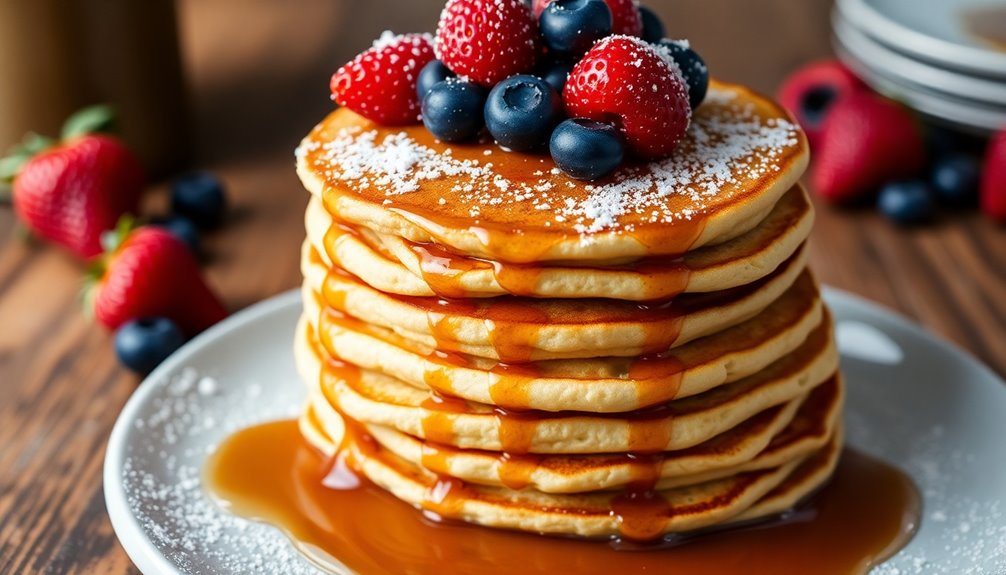
Elevate your coconut flour pancakes with a variety of serving suggestions that will make your breakfast feel special. Start with a beautiful presentation by stacking your pancakes high on a plate. Drizzle pure maple syrup over the top, allowing it to cascade down the sides. For an added touch of color, sprinkle fresh berries like blueberries or strawberries, bringing vibrant flavors and nutrients to your meal.
Consider adding a dollop of Greek yogurt or whipped cream on the side for a creamy complement. This pairing not only enhances the texture but also balances the sweetness of your pancakes beautifully.
You can also experiment with flavor combinations by mixing in a hint of cinnamon or nutmeg into the yogurt, creating a delightful dip that your friends and family will love.
If you want to go the extra mile, serve your pancakes alongside crispy bacon or savory sausage. The salty crunch of these accompaniments contrasts wonderfully with the fluffy sweetness of the pancakes, creating a satisfying breakfast experience.
For an invigorating twist, try a side of sliced peaches or a citrus salad; their brightness will awaken your palate and make your breakfast feel even more special.
Don't forget about nuts! Chopped walnuts or pecans sprinkled on top will add a satisfying crunch and boost the health factor of your meal. With these serving suggestions, you'll create a delightful breakfast spread that feels inviting, satisfying, and full of flavor. Enjoy every bite!
Storage and Reheating Tips
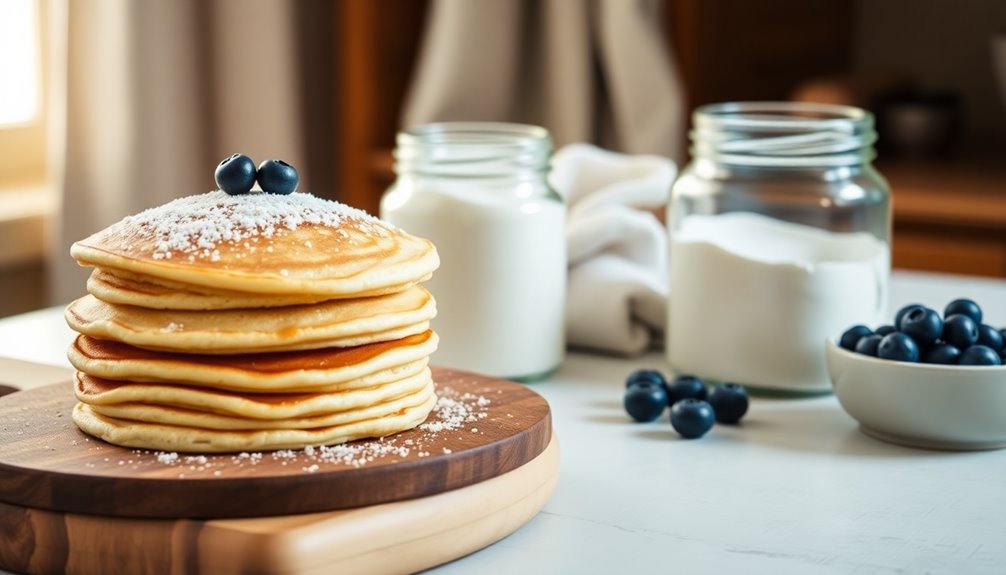
Storing your coconut flour pancakes properly keeps them fresh and ready for a delicious meal later on. After you've enjoyed your breakfast or brunch, don't let those leftovers go to waste!
Allow the pancakes to cool completely and then stack them with parchment paper between each pancake to prevent sticking. Place the stack in an airtight container or a resealable plastic bag. This way, you can enjoy them throughout the week without losing that delightful texture and flavor.
If you want to keep them for longer, consider freezing leftovers. Just follow the same cooling and stacking method, then pop the container or bag in the freezer. They can last up to three months, making it easy to have a quick meal on hand whenever hunger strikes.
When it's time to indulge again, reheating methods are key. If you're in a hurry, the microwave works wonders—simply pop a pancake on a plate, cover it with a damp paper towel, and heat for about 30 seconds. For those who prefer a crispier edge, try a skillet on medium heat. Just add a tiny bit of butter or oil and warm each pancake for a minute or two on each side.
No matter how you choose to reheat them, your coconut flour pancakes will be just as scrumptious as when they first came off the griddle. Enjoy knowing that every bite is a step toward cozy comfort and shared moments with loved ones!
Frequently Asked Questions
Can I Substitute Coconut Flour With Other Flours in Pancakes?
Sure, you can absolutely substitute coconut flour with other flour alternatives in your pancake recipe! Just remember that different flours absorb moisture differently, so you might need to tweak your recipe modifications.
For instance, using almond flour might require you to reduce the liquid, while whole wheat flour could add a heartier texture. Experimenting with these alternatives can lead to delicious results, making your pancake mornings even more exciting and flavorful!
Are Coconut Flour Pancakes Suitable for a Gluten-Free Diet?
Absolutely, coconut flour pancakes are perfect for a gluten-free diet! They offer unique nutritional benefits, like being high in fiber and healthy fats, which can keep you feeling satisfied.
When cooking, remember to adjust your liquid ratios since coconut flour absorbs moisture differently. Experimenting with flavors and toppings can make them even more delightful.
You'll find that these pancakes not only fit your dietary needs but also bring a sense of community to your breakfast table!
How Do I Make Coconut Flour Pancakes Vegan?
Imagine a fluffy cloud drifting through a sunny sky, inviting you to indulge in a delightful experience.
To create your vegan pancakes, mix coconut flour with almond milk, flaxseed meal, and a pinch of baking powder. Whisk until smooth, then cook until golden.
Top your fluffy creations with vegan toppings like maple syrup, fresh berries, or a dollop of coconut yogurt.
You'll feel a sense of belonging as you savor each guilt-free bite!
What Is the Shelf Life of Coconut Flour?
Coconut flour typically lasts about 12 months when stored properly in a cool, dark place. After opening, it's best to keep it in an airtight container for freshness.
This flour's shelf life makes it a great choice for your baking recipes, allowing you to enjoy its unique flavor and nutritional benefits over time.
Plus, using coconut flour in your creations can help you connect with others who appreciate healthy, delicious options in their meals.
Can I Freeze Leftover Coconut Flour Pancakes?
Sure, you can freeze those leftover pancakes like they're the last slice of pizza at a party! Just stack them with parchment paper, pop them in a freezer bag, and seal tightly.
For reheating, you've got options: toss them in the microwave for a quick fix or warm them on a skillet for that fresh-off-the-griddle taste.
With these freezing tips, you'll never waste a pancake again! Enjoy your culinary creations!
Conclusion
As you savor your golden-brown coconut flour pancakes, the warm aroma of coconut fills the air, wrapping you in a cozy embrace. Each fluffy bite dances on your taste buds, a delightful reminder of the nourishing benefits packed within. These pancakes aren't just a treat; they're a nourishing experience that brings comfort and joy to your breakfast table. So, whip up a batch and let the simple pleasure of homemade goodness brighten your day. Enjoy every moment!

